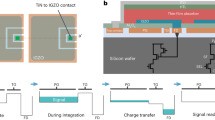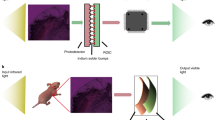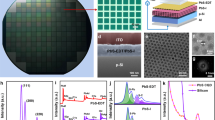Abstract
One billion image sensors worldwide render optical images as digital photographs in video cameras, still cameras and camera phones. These silicon-based sensors monolithically integrate photodetection with electronic readout. However, silicon photodiodes rely on a smaller bandgap than that required for visible detection; this degrades visible-wavelength sensitivity and produces unwanted infrared sensitivity. Thin-film top-surface visible photodetectors have therefore been investigated based on amorphous1, organic2 and colloidal quantum-dot3 semiconductors. However, none of these devices has exhibited visible sensitivity approaching that of silicon. Here we report a sensitive solution-processed photodetector that, across the entire visible spectrum, exhibits D* (normalized detectivity) greater than 5 × 1012 Jones (a unit of detectivity equivalent to cm Hz1/2 W−1). A photoconductive gain of >100 has been measured, facilitating high-fidelity electronic readout, and the linear dynamic range is greater than 60 dB, as required for high-contrast applications. These photodetectors are also compatible with flexible organic-based electronics.
This is a preview of subscription content, access via your institution
Access options
Subscribe to this journal
Receive 12 print issues and online access
$209.00 per year
only $17.42 per issue
Buy this article
- Purchase on Springer Link
- Instant access to full article PDF
Prices may be subject to local taxes which are calculated during checkout



Similar content being viewed by others
References
Theil, J. A. a-Si:H photodiode technology for advanced CMOS active pixel sensor imagers. J. Non-Cryst. Solids 299–302, 1234–1239 (2002).
Peumans, P., Bulovic, V. & Forrest, S. R. Efficient, high-bandwidth organic multilayer photodetectors. Appl. Phys. Lett. 76, 3855–3857 (2000).
Oertel, D. C., Bawendi, M. G., Arango, A. C. & Bulovic, V. Photodetectors based on treated CdSe quantum-dot films. Appl. Phys. Lett. 87, 213505–213507 (2005).
Vygranenko, Y., Chang, J. H. & Nathan, A. Two-dimensional a-Si: H n-i-p photodiode array for low-level light detection. IEEE J. Quant. Electron. 41, 697–703 (2005).
Staebler, D. L. & Wronski, C. R. Reversible conductivity changes in discharge-produced amorphous Si. Appl. Phys. Lett. 31, 292–294 (1977).
Konstantatos, G. et al. Ultrasensitive solution-cast quantum dot photodetectors. Nature 442, 180–183 (2006).
Crone, B. et al. Large-scale complementary integrated circuits based on organic transistors. Nature 403, 521–523 (2000).
Someya, T. et al. A large-area, flexible pressure sensor matrix with organic field-effect transistors for artificial skin applications. Proc. Natl Acad. Sci. USA 101, 9966–9970 (2004).
Someya, T. et al. Integration of organic FETs with organic photodiodes for a large area, flexible, and lightweight sheet image scanners. IEEE Trans. Electron. Devices 52, 2502–2511 (2005).
Hines, M. A. & Scholes, G. D. Colloidal PbS nanocrystals with size-tunable near-infrared emission: observation of post-synthesis self-narrowing of the particle size distribution. Adv. Mater. 15, 1844–1849 (2003).
Cho, K. S., Talapin, D. V., Gaschler, W. & Murray, C. B. Designing PbSe nanowires and nanorings through oriented attachment of nanoparticles. J. Am. Chem. Soc. 127, 7140–7147 (2005).
Fossum, E. R. CMOS image sensors: Electronic camera-on-a-chip. IEEE Trans. Electron. Dev. 44, 1689–1698 (1997).
Acknowledgements
The authors thank S. Hoogland for assembling part of the experimental set-ups used and D. Holmyard for his help with transmission electron microscopy imaging.
Author information
Authors and Affiliations
Corresponding author
Ethics declarations
Competing interests
The authors declare no competing financial interests.
Supplementary information
Supplementary Information
Figures SM1 and SM2 (PDF 79 kb)
Rights and permissions
About this article
Cite this article
Konstantatos, G., Clifford, J., Levina, L. et al. Sensitive solution-processed visible-wavelength photodetectors. Nature Photon 1, 531–534 (2007). https://doi.org/10.1038/nphoton.2007.147
Received:
Accepted:
Published:
Issue Date:
DOI: https://doi.org/10.1038/nphoton.2007.147
This article is cited by
-
Suppression of Leakage Currents in Photo-multiplication Photodetectors with Oxidation-Controlled Metal Interfacial Layer
Electronic Materials Letters (2024)
-
High-performance photodetection sensors based on (S2Ge)100−x(S3Sb2)x (x = 15, 30, 45, 60) system for optoelectronics applications
Journal of Materials Science: Materials in Electronics (2023)
-
Electrical Performance of Amorphous Oxide/Colloidal Quantum Dot/Amorphous Oxide Hybrid Thin Film Transistor
Transactions on Electrical and Electronic Materials (2022)
-
Oxygen vacancies modulating self-powered photoresponse in PEDOT:PSS/ε-Ga2O3 heterojunction by trapping effect
Science China Technological Sciences (2022)
-
Silicon: quantum dot photovoltage triodes
Nature Communications (2021)



